What Is Backstrap Meat And What Can You Do With It?
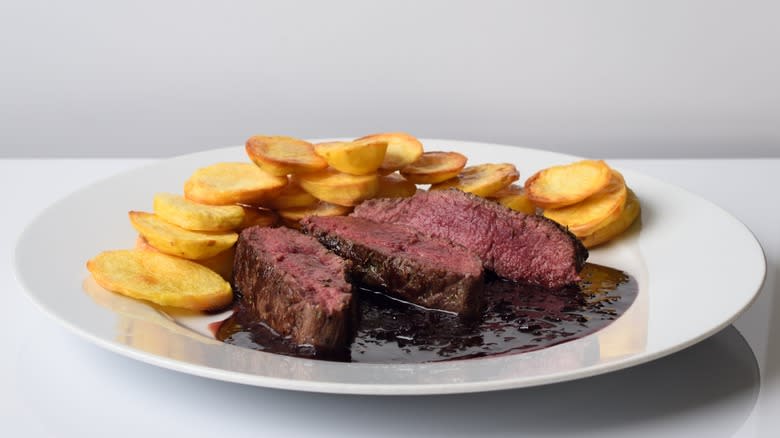
Backstrap (Longissimus dorsi) consists of the long strips of muscle that start at the shoulder blades on deer, elk, moose, and other four-legged animals and run down the length of the spine, all the way to the final vertebrae. Generally, when most people talk about backstrap they are referring to venison -- or deer meat. This cut is renowned for being especially tender and low in fat. Although it is a muscle, it is not one that is in constant use -- hence its tenderness.
There are a variety of dishes that can be made with backstrap, including grilled or pan-seared steaks, medallions, kebabs, venison steak tartare, and chops. Backstrap is also an excellent cut for everything from fajitas to a big juicy roast and it goes well in chili or breaded and fried for crusted venison. Another great option is stuffing the cut and then wrapping it in bacon. Since it is a muscle it's best cooked on the rarer side and it will become tough and chewy if it is overcooked, so it's important to keep that in mind when selecting how to prepare a backstrap. Of course, if tenderness is not the goal, it can also be dried and made into jerky.
Read more: The 13 Best Steaks For Grilling
What Is Backstrap?

As you probably already suspect, the backstrap is a pretty large cut of meat -- roughly the length of a grown man's arm. And the bigger the deer, the longer the backstrap is going to be. As a single piece, it is long and tubular, but it can be butchered into smaller individual pieces to make it more manageable. It is also boneless, but it can be left on the ribs for bone-in chops. While the deer is still alive, its pair of backstraps are the part of its body that controls its back and allows it to sprint and jump.
This extra lean cut of venison has a deep, dark color that hints at its richness. While it looks a lot like beef after it has been cooked, it will have a stronger, earthier flavor. Naturally, the best way to acquire a backstrap is by hunting, but purchasing it from a retailer is possible if that's more realistic for you.
Backstrap Vs. Tenderloin
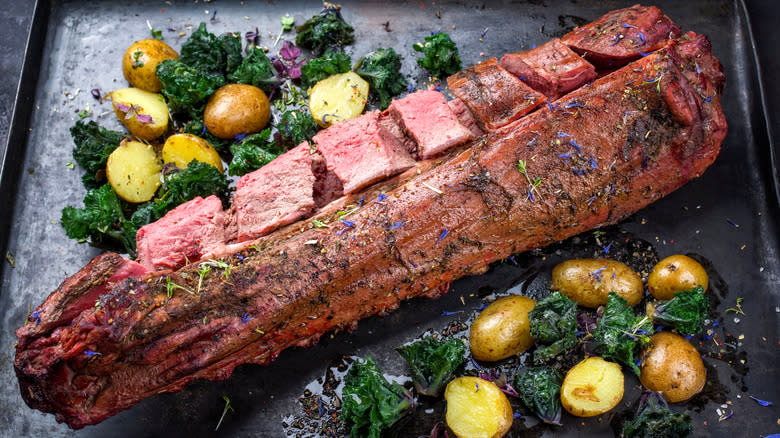
Among people who are new to hunting, the backstrap is often confused with the tenderloin. As another spectacularly tender piece, it makes sense that people often confuse the two, but they are actually very different cuts of venison. Whereas the backstraps sit on top of the spine and cover its length, the tenderloins are underneath it and inside the body cavity. At only about a foot long, the tenderloins are also quite a bit smaller than the backstraps.
It's also much harder to get to the tenderloins due to their location, but it's well worth it as the cut does live up to its namesake. The backstraps, on the other hand, are relatively easier to get to and they can be removed right away after the skinning process is done. Although most people are familiar with tenderloins, the backstrap doesn't always get the attention that it deserves.
What Does Backstrap Taste Like?
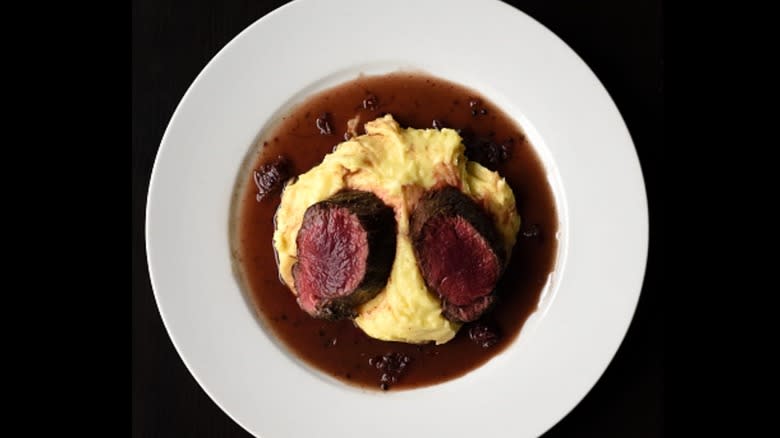
Since backstrap most commonly comes from venison, many people may describe it as having a gamey flavor. This can be off-putting to some but it doesn't have to be. How the deer is handled and processed will affect the level of gaminess that the cut takes on, as will the care with which it is cooked. Gaminess can also be eliminated by soaking the meat overnight in a brine or vinegar solution -- just be sure to keep it refrigerated. Marinades can also help eliminate the strong flavor.
Deer meat is also described as earthy, with notes from the variety of wild foods that the animal indulges in. This can include different herbs such as sage and nuts like acorns. It is less juicy than beef, with a firmer texture. Venison in general is a very rich meat, and backstrap is not an exception to this. But it also has a very lean taste owing to the lack of fat in the muscular cut.
How To Cook Backstrap
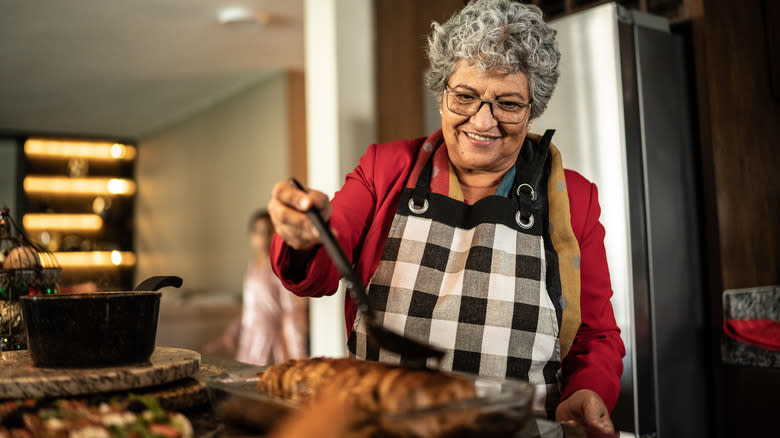
Backstrap is generally best cooked rare or medium rare. Aim for an internal temperature of 125 Fahrenheit for rare, 130 for medium rare, and 135 for medium. Since you never want to let it get above 140, this is not the kind of cut that can be enjoyed by those who have to have their meat cooked to well done. Overcooking the backstrap muscle will cause it to lose its tenderness, ruining this otherwise delectable cut of venison and making it super tough. Searing, grilling, and pan frying are all popular ways to cook backstrap. Almost any cooking method will do as long as it is not overcooked to the point of being tough.
While not all parts of a deer can be eaten raw, backstrap is one that can be -- if it is harvested, processed, and handled safely enough to do so. Of course that doesn't mean that it doesn't come with some level of risk. In addition to the usual dangers associated with raw meat, hunters have contracted the parasite Toxoplasma gondii (which causes blindness) from uncooked venison -- including backstrap.
Where To Buy Backstrap
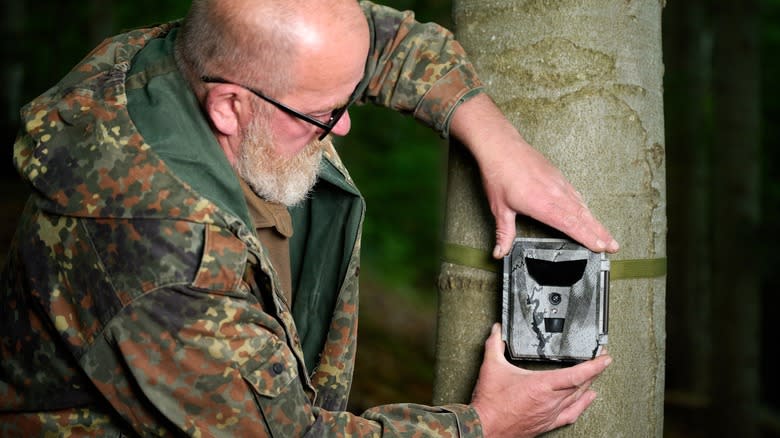
For the most part, this isn't a cut that you're going to be able to buy at your local supermarket. Venison isn't generally available at grocery stores in the U.S. like it is in the U.K. In fact, wild game is prohibited from being sold in the United States, though there are plenty of farms that raise and sell venison, including backstrap. While you can check with your local butcher, your best bet is going to be to order it online directly from the farm or distributor.
That being said, most people do get their backstrap and other deer products from the great outdoors. If you're not a hunter consider asking a friend or family member who is. If you like it enough, it just might be worth taking up hunting. After all, harvesting and butchering your own meat is the best way to tell just how fresh it is.
Other Varieties Of Backstrap
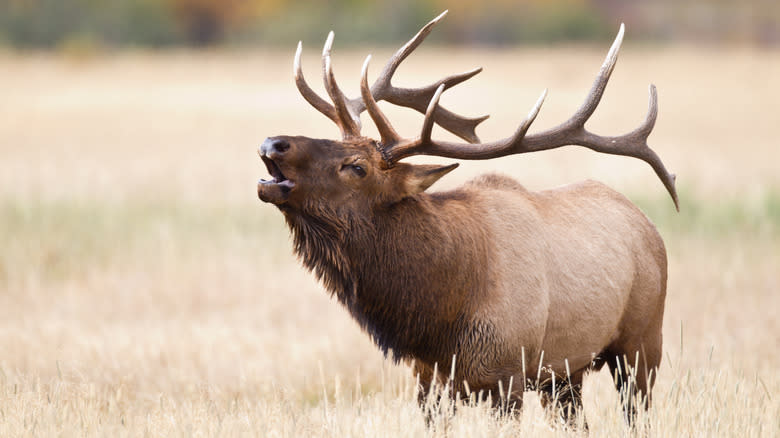
In addition to backstrap from deer, the cut can also be taken from an elk or even a moose -- as well as lamb, antelope, and more. Obviously, the elk version will be substantially longer than the deer, and the moose will be even longer than that. There is also a significant difference in taste between them.
As with the deer version, an elk's backstrap is its most tender cut (along with the tenderloin, of course). But although deer and elk are very similar animals, they have a very different flavor. Whereas deer tend to be earthy and gamey, elk meat is much more similar to beef in taste. Moose, on the other hand, tastes like a cross between the two -- with a flavor similar to deer but without the gaminess, making it more mellow like beef. As the smaller of the three and available in more states, deer is naturally more commonly hunted. As such, it is easier to source and therefore generally what most people mean when they refer to backstrap.
Read the original article on Daily Meal.

